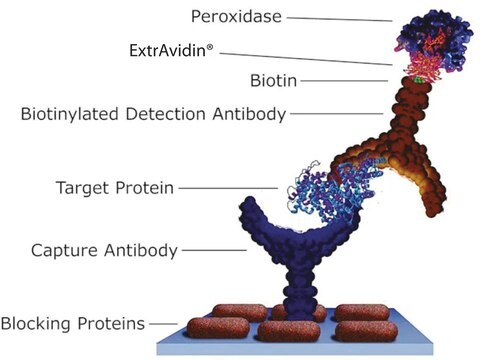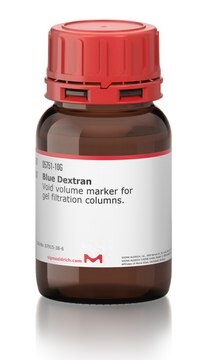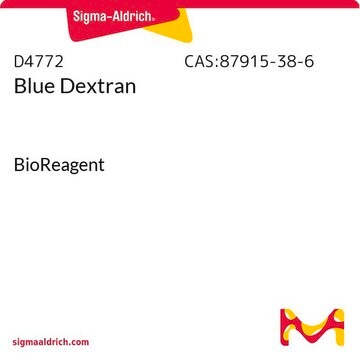A7419
Avidin–Peroxidase
buffered aqueous solution
Synonym(s):
Avidin–HRP
Sign Into View Organizational & Contract Pricing
All Photos(2)
About This Item
Recommended Products
biological source
avidin from egg white
enzyme from horseradish
Quality Level
conjugate
peroxidase conjugate
form
buffered aqueous solution
technique(s)
indirect ELISA: 1:100,000
western blot: 1:400,000-1:800,000 using detecting β-Actin in total cell extract of HeLa cells (5-10 μg/well)
shipped in
dry ice
storage temp.
−20°C
General description
Avidin is homotetrameric protein (68kDa) obtained from egg whites and binds strongly to biotin. Thus, avidin-biotin association has been utilized in immunoassays to detect the localization of antigens in tissues. The use of avidin-biotin immunoassay enhances the sensitivity of the technique and facilitates the detection of antigens in low quantities.
Application
Avidin-Peroxidase has been used for ELISA applications. The product can also be used for western blot applications at dilutions ranging from 1:400,000 to 1:800,000.
Western blot analysis of proteins in HUVEC cells that had underwent cell surface biotinylation were detected using HRP-conjugated avidin at 33.3 ng/ml.
Physical form
Solution in 0.01 M phosphate buffered saline, pH 7.4, containing 0.05% MIT.
Preparation Note
Affinity purified protein.
Disclaimer
Unless otherwise stated in our catalog or other company documentation accompanying the product(s), our products are intended for research use only and are not to be used for any other purpose, which includes but is not limited to, unauthorized commercial uses, in vitro diagnostic uses, ex vivo or in vivo therapeutic uses or any type of consumption or application to humans or animals.
Storage Class Code
12 - Non Combustible Liquids
WGK
WGK 2
Flash Point(F)
Not applicable
Flash Point(C)
Not applicable
Choose from one of the most recent versions:
Already Own This Product?
Find documentation for the products that you have recently purchased in the Document Library.
Customers Also Viewed
Clare Baecher-Allan et al.
Journal of immunology (Baltimore, Md. : 1950), 169(11), 6210-6217 (2002-11-22)
CD4(+)CD25(+high) T cells are potent regulators of autoreactive T cells. However, it is unclear how regulatory CD4(+)CD25(+high) cells discriminate between desirable inflammatory immune responses to microbial Ags and potentially pathologic responses by autoreactive T cells. In this study, an in
Juan Manuel Valverde et al.
Toxicon : official journal of the International Society on Toxinology, 127, 106-111 (2017-01-16)
Adjuvant emulsions are widely used to enhance the antibody response of the animals used as immunoglobulin source for producing antivenoms. Usually, the adjuvant activity of emulsions is attributed both to their ability to trigger "danger" signals from cells in which
Prajna Lalitha et al.
American journal of ophthalmology, 144(4), 552-556 (2007-08-19)
To study the range of ocular symptoms in a cohort of patients with chikungunya infection. Retrospective, observational case series. Patients attending a tertiary eye care hospital in South India were included in the study. We included adult patients with serologically
Dominika Lukas et al.
Proceedings of the National Academy of Sciences of the United States of America, 114(8), E1480-E1489 (2017-02-09)
TGF-β is an anti-inflammatory cytokine whose signaling is negatively controlled by Smad7. Previously, we established a role for Smad7 in the generation of autoreactive T cells; however, the function of Smad7 in dendritic cells (DCs) remains elusive. Here, we demonstrate
Juliana Portes et al.
Frontiers in cellular and infection microbiology, 10, 294-294 (2020-07-28)
Toxoplasma gondii, the causative agent of toxoplasmosis, is an obligate intracellular protozoan parasite. Toxoplasma can invade and multiply inside any nucleated cell of a wide range of homeothermic hosts. The canonical process of internalization involves several steps: an initial recognition
Our team of scientists has experience in all areas of research including Life Science, Material Science, Chemical Synthesis, Chromatography, Analytical and many others.
Contact Technical Service











